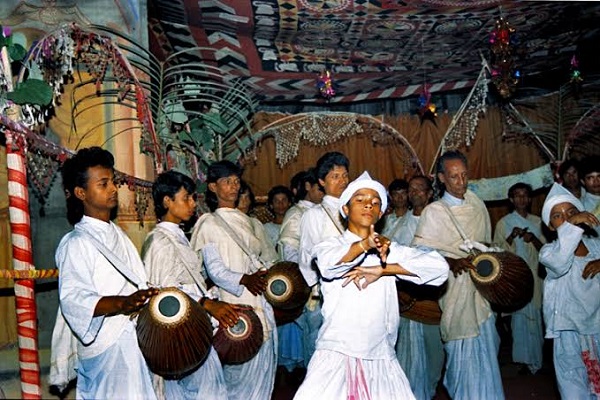In travelling through Assam, one will find a number of facets that are unique to the socio-cultural mores of the state. Other than being a wonderful destination for appreciating culture, nature, and tradition, Assam is an amazing place to visit if you like the idea of luxury river cruises in India. One of the many jewels you will encounter as you travel through the state, either by road, or by the mighty Brahmaputra, are satras.
Institutional centres that are associated with the Ekasarana tradition of Vaishnavism, satras are more than simple monasteries, they are also hubs for the more traditional forms of performing arts. Founded by Sankardeva, the father of Assamese culture, the first satra was established in Majuli in the 15th century, one of the largest river islands in the world, and a popular stop for many river cruises in India. Peppered around the state, and some neighbouring areas, the satras are usually independent, and under the control of individual adhikaras, though they are grouped into four different orders, or sanghatis.
All satras maintain a prayer house to help initiate lay folk into the Ekasarana tradition, and accept them as disciples of the satra, after which taxes and related religious duties would be extracted. After their birth in the 15th century, they gained popularity, and rapidly grew in the 17th century, after the Koch Kingdom, and later the Ahom Kingdom, became patrons of the institutions. This patronage was crucial in the spread of the Ekasarana faith. Consequently, the prestige of satras can vary greatly. Some can be small, close knit communities, while others can be much larger. These can house hundreds of monks, celibate and otherwise, posses vast land holdings, and are repositories of cultural and religious artifacts and relics that could just as easily be found in a museum.
Satras are generally walled off enclosures that have four gateways, or karapat. The rectangular prayer hall is usually situated in the centre, aligned from east to west. The most sacrosanct place in a satra is the manikut, which contains the main object of worship (usually a copy of the Bhagwat Purana manuscript, or an idol. The prayer hall is surrounded by rows of huts, which are called hati, in which the monks live. The higher monks and the Adhikara reside in the eastern hatis. Satras also offer guest accommodation where devotees and visitors can also take part in worship, but also watch traditional performances – some of the cultural programmes that can be enjoyed are theBhaona, the Doul Utsav, Janmastami, and the Rasa Lila. One of the eight classical dance forms of India, Sattriya, was initiated and developed with the satras.
The satras are also doors to explore the art and crafts of the state as well. Some of the young monks, or bhakats, are accomplished artisans and craftsmen. They are adept at making masks, some musical instruments, as well as door frames and hand-fans.
Given that they originated there, Majuli has a number of functional satras. With original numbers over 65, there are now 22 satras on the island. Others had to be moved to safer places, away from the threat of flooding and subsequent erosion. If you are considering embarking on one of the best river cruises in India, you can definitely visit the island on your trip. The optimum time to visit the island is in November, when the Raas festival would be in full swing. You can then take a stroll and visit some of the more prominent satras.
For Paalnaam and the apsara dance, you can visit Auni-ati, which also houses an extensive collection of ancient Assamese artifacts such as jewellery, handicrafts, and utensils. Dakhinpat is the centre of the Rasleela, which is observed as one of Assam’s main festivals. Thousands of devotees visit the holy satras every year during Rasotsava. The Rasleela is also performed with great enthusiasm at the Garamur satra, which also houses traditional cannons known as bortop. Satras are centre’s of art, culture, literature, and classical studies. Satras such as Shamaguri and Kamalabari are renowned for their mask-making traditions, and for their boat-making, respectively. The Bengena-ati satra is a premier centre for the performing arts, and for many traditional crafts. This satra also houses the royal gold umbrella and gilded robes of the Ahom king, Swargadeo Gadadhar Singha.
The magic of the satras is one of the many memorable experiences guests can have while travelling onboard the MV Mahabaahu. Please find the detailed itinerary here (Click Here)





















Leave a Reply
You must be logged in to post a comment.